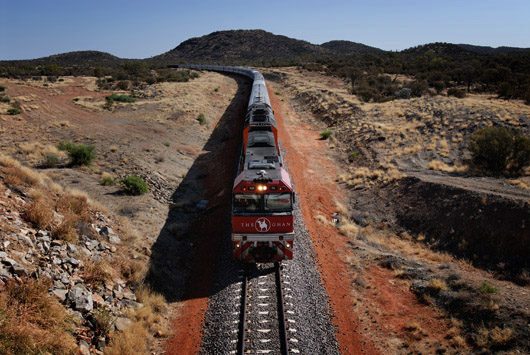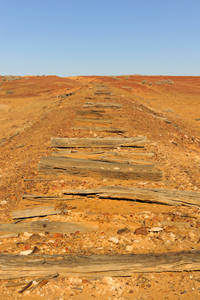A.bc
In Australia, sulle tracce di Chatwin 20 anni dopo Le Vie dei Canti
Palazzo delle Esposizioni, Roma
A.bc
In Australia, in Chatwin's footsteps 20 years after The Songlines Palazzo
Delle Esposizioni, Rome


In
"Le Vie dei Canti" Arkady Volchok mappava i luoghi sacri degli
aborigeni per non farli attraversare dalla nuova linea ferroviaria che
avrebbe unito Alice Springs a Darwin. Nella realtà, solo nel 2004
- vent’anni dopo - si è riusciti a completare la costruzione
della tratta; prima, sbagliando clamorosamente i calcoli, fu tracciato
su terreni che con la stagione delle piogge si inondarono. Ora quella
linea che taglia l’outback è percorsa dal leggendario Ghan:
2979 km in 47 ore, su e giù tra Adelaide e Darwin, due o tre volte
alla settimana (a seconda delle stagioni), sostando per qualche ora nelle
quattro fermate tra i due capolinea, trasportando backpackers, gruppi
organizzati e turisti da suite Gold Kangaroo. La leggenda del Ghan –
che prende il nome dai cammellieri afghani fatti arrivare nell’800
per la capacità di muoversi con i loro animali nel deserto - inizia
nel 1877, quando viene progettato per la prima volta di unire con la strada
ferrata il sud e il nord del continente. Sul vecchio Ghan, di cui rimangono
alcune stazioni abbandonate nel bush tra Adelaide e Alice, c’è
una ricca aneddotica: da quando i primi passeggeri completavano il percorso
su vagoni trainati da cammelli, a quando per le piogge devastanti, con
tanto di provviste paracadutate ai passeggeri bloccati, si accumulavano
fino a dieci giorni di ritardo. Oggi, ad accogliere i viaggiatori alla
stazione di Alice c’è, a ogni arrivo, Milton, sessantenne
attore-giullare-cicerone, che mentre i turisti sciamano verso pullman,
taxi e minibus, per le due ore di visita della città o la partenza
immediata verso i must Uluru e Kata Tjuta, decanta con voce stentorea
le qualità di Alice, la “porta del deserto”, la regina
dell’outback
Ciò che resta dei binari della vecchia linea del Ghan, oggi abbandonata, che dal 1878 al 1980 ha unito il nord e il sud dell’Australia

Ciò che resta dei binari della vecchia linea del Ghan, oggi abbandonata, che dal 1878 al 1980 ha unito il nord e il sud dell’Australia

In
"The Songlines" Arkady Volchok mapped the sacred places of the
Aboriginal people to prevent the new railway line that would connect Alice
Springs to Darwin from crossing them. In reality, the construction of
the railway was completed only in 2004 - after two decades; previously,
making terrible mistakes in calculations, it had been traced on lands
that during the rainy season were flooded. Now that line that crosses
the outback is covered by the legendary Ghan: 2,979 km in 47 hours, up
and down between Adelaide and Darwin, two or three times a week (depending
on the season), stopping over for a few hours in the four stations between
the two terminus, carrying backpackers, organized groups and Gold Kangaroo
suite tourists. The legendary Ghan - which takes its name from Afghan
camel-drivers who were called to the country in the XIX century because
they were able to move with their animals in the desert - begins in 1877,
when it is planned for the first time to join the south to the north of
the continent by railway. There are a lot anecdotes about the old Ghan,
of which some abandoned stations remain in the bush between Adelaide and
Alice: from when the first passengers completed their journey on wagons
drawn by camels, to when, because of the devastating rains, the train
accumulated up to ten days of delay. Today, travellers are welcomed at
Alice station by Milton, a 60 years old actor-minstrel-guide, who, while
tourists swarm to buses, taxis and minibuses for the two hours of sightseeing
or the immediate departure to Uluru and Kata Tjuta, sings in a stentorian
voice the qualities of Alice, the "door of the desert", the
queen of the outback
Remains of the old rail track of the Ghan - today abandoned – which used to link North and South Australia from 1878 to 1980
Remains of the old rail track of the Ghan - today abandoned – which used to link North and South Australia from 1878 to 1980